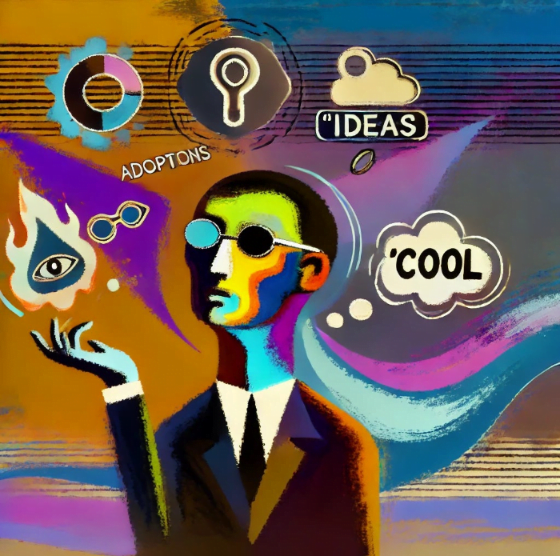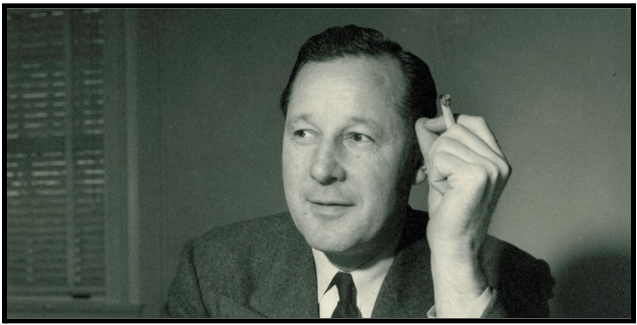The aesthetics of information (and reflections on luxury beliefs).
Talking Big Ideas.
This week’s guest columnist is Dan Williams.
Dan is a Cambridge-educated philosopher who writes with an authenticity and erudition that reminds me of Chris Hitchens. I’ve never met Dan – he’s one of the many brilliant authors I’ve discovered here at Substack – though I thoroughly enjoy how he explores psychology and the social function of our beliefs.
If you enjoy today’s essay, I encourage you to subscribe to Dan’s Substack Conspicuous Cognition, where Fashionable Ideas was first published.
In an ideally rational world, people would evaluate ideas based solely on their epistemic merits. What is the quantity and quality of evidence for a hypothesis? Does it cohere with well-established bodies of scientific knowledge? What precise, surprising predictions does it generate? Does it provide a basis for powerful and parsimonious explanations, unifying otherwise disparate phenomena? And so on.
Needless to say, people fall very short of this ideal. There are many familiar reasons for this, such as cognitive laziness, self-serving bias, tribalism, and social conformity. However, I think one reason is curiously under-explored: the aesthetics of beliefs.
People often gravitate towards ideas because they are, in some sense, cool. They embrace beliefs and theories much like they choose clothes—based on what’s fashionable or trendy. They ask, albeit implicitly and instinctively, “Would this idea look good on me?” “Is it chic to think and talk in this way?” “Does this belief suit my style and convey the right messages about me?”
This is very noticeable as a humanities academic. Many influential thinkers and ideas within the humanities are clearly treated as trendy. As with other fashions, this status changes over time, and different thinkers and ideas are cool to different communities, but the phenomenon is striking nonetheless.
I see it a lot in how students respond to different thinkers. Marx? Cool. Judith Butler? Cool. Camus? Cool. The logical positivists? Not cool. John Rawls? Actively uncool. Bertrand Russell? Cringe. And so on.
If there is a rough pattern in such judgements, it is probably something like “radical, subversive, obscure, left-wing, etc. = cool”, “moderate, conservative, clear, scientific, etc. = uncool.” However, many exceptions exist, and the assessments change over time.
Of course, the idea of “fashionable beliefs” is a familiar trope in everyday discourse. It is often used—unfairly—to demonise other people by implying their views are frivolous and irrational. Nevertheless, I think the concept captures a deep, understudied phenomenon that is widespread, at least among highly educated people in affluent societies with the luxury to “play with ideas.”
The signalling function of beliefs
Most beliefs simply make up our mental model of reality. There is milk in the fridge. People have eyes. Bananas are fruit. Sally is talking. London is in England. These and countless other bits of information are stored in your brain in various formats. They help you navigate reality effectively and achieve your goals.
When constructing this mental model, accuracy is crucial. It is not the only value. You—or your brain—also care about things like speed, efficiency, and computational tractability. For this reason, mental models are inevitably selective and idealised in many ways. But although all models are wrong, mental models must typically be sufficiently accurate—sufficiently not-wrong—to help people navigate the world and make good decisions.
However, some of our beliefs—or at least our “beliefs”1—are different. We endorse these beliefs not to model the world accurately but to send social signals about the kinds of people we are. They are socially adaptive beliefs.
This signalling is simply an extension of much human behaviour. As ultra-social animals, the greatest determinant of our well-being and success is typically what others think of us. Are we liked and approved of? Do people want us as a partner or friend? Are we welcomed into the local tribe and respected and admired within it?
For this reason, people invest enormously in behaviours and outward markers that signal desirable traits. They waste time and money on luxury goods that signal their wealth and status. They participate in costly—sometimes agonising—group rituals to signal tribal solidarity. They try to destroy other people’s reputations on social media to signal that they are True Progressives or True Conservatives. And so on.
This incessant social signalling drives most of the weirdest things humans do. It also drives most of the weirdest things people believe. Just as clothes selected entirely for their expressive value can be pretty bizarre, the same is true of beliefs selected entirely for the purpose of impression management.
Fashion and signalling
It is tempting to assimilate the concept of “fashionable beliefs” to this phenomenon of belief signalling. However, this would be simplistic. In many cases, the signals people are motivated to send in adopting and affirming beliefs have little to do with fashion or trendiness.
For example, many religious and ideological narratives are rooted in signals of tribal membership and allegiance. If I profess to believe that God is three persons and one, that Muhammad was a prophet, or that the history of all hitherto existing society is the history of class struggles, I send a clear signal that I am a good, loyal member of the relevant tribe defined by such beliefs.
Likewise, many widespread beliefs are rooted in the motivation to signal that one is moral and norm-abiding. For example, if I profess to believe that God is always watching, or that I will go to hell if I violate moral rules, or that a crocodile-like spirit will hunt me down if I do not share my meat with fellow group members, I send a clear signal that I am likely to behave morally and cooperatively—that is, as God (or the crocodile-like spirit) wants me to behave.
However, motivations to signal tribal allegiances and moral dispositions differ greatly from the motivations at play in assessments of fashion and trendiness.
This is obviously true in the domain of clothing and conduct. For example, when choosing jewellery, signalling that one is a good Christian is very different from signalling that one is hip or stylish. But it is also true in the domain of belief. Beliefs that signal tribal allegiances or prosocial dispositions do not themselves signal trendiness. In fact, trendiness can be actively opposed to these signals. Being a good, loyal, conformist, norm-abiding community member is not very cool.
Given this, fashionable beliefs are a distinct kind—a proper subset—of beliefs that function as social signals. So, this raises two questions:
- What specific content is signalled when something is fashionable?
- Why and how do motivations to communicate this message influence beliefs?
The short, honest answer to both questions is “I have no idea.” Here are some longer, speculative answers.
Fashion
What is fashion? What makes something fashionable—or cool, trendy, hip, or whatever? Why do fashions change?
In thinking about these questions, I am doubly disadvantaged: not only have I never been cool, but I also have no intellectual expertise on the topic. However, I came across an interesting theory from Judith Donath, taken from chapter abstracts for a book she seems not to have published:
“Fashion, often thought of as foolish and frivolous, is actually a signal of one’s adeptness and adaptability in an information society. It indicates one’s level of access to new information and willingness to change continuously. With information becoming the key source of power and influence in our society, fashion is becoming an increasingly significant signal.”
There is something that seems right about this. To be fashionable and make reliable evaluations about fashion—to have good “taste”—requires esoteric knowledge, a kind of cultural capital. Because people differ in their ability to access and exploit this knowledge, people differ in how fashionable they are. And because the relevant knowledge must constantly evolve to perform this distinguishing function, fashions must similarly change constantly.
Donath goes on:
“Fashions are signals where the form of the signal changes over time while the indicated quality, generally one’s affiliation to and status within a particular social group, remains the same. There are fashions in clothing, music, language and ideas – indeed, any changeable, information-based expression. Just as displays of strength indicate one’s prowess in the physical world, and displays of money indicate one’s prowess in the financial world, displays of fashion indicate one’s prowess in the information world.”
Interestingly, Donath links fashion, so understood, to specific cultural contexts:
“Fashion signals occur in socially mobile cultures, where status is highly contested and knowledge and social connections are essential. As a widespread cultural phenomenon, fashion first emerged in Europe in the 14th to 17th centuries, as the rise of merchant and artisan classes brought new social mobility, and technological and scientific developments ushered in a world in which change and a belief in progress replaced the stasis of the medieval world. In the following centuries, information flow has accelerated, and so has the rate of change in fashion. Whereas 16th century fashions might change over a period of months or years, today there are fashions that emerge and sink within the course of a few days.”
What, then, does being fashionable signal?
“Fashion signals access to information within a particular social affiliation, one’s willingness to adapt to new ways of doing things, and one’s commitment to that affiliation. Keeping up with changing fashions requires knowing which fashion to follow (thus signaling information access) and spending time, money or other resources on frequent updates (thus signaling need and commitment).”
This is an interesting theory. However, the idea of “access to information” seems weirdly under-specified. Information about what? There are many forms of scarce, difficult-to-acquire knowledge disconnected from fashion. I have extensive knowledge of the little-known ideas of mid-twentieth-century cybernetician Kenneth Craik, which, sadly, has not made me cool.
Perhaps this is where the connection with class or social status comes in. (Donath alludes to this in her comments about socially mobile societies and the importance of social connections).
Fashion and status
According to Quentin Bell, fashion is rooted in a simple rule (quoted here): “Try to look like the people above you; if you’re at the top, try to look different from the people below you.”
This suggests that the information relevant to fashion is access to elites’ evolving status symbols. This is challenging to acquire. Among other things, it requires high-status social connections and the ability to soak up useful, often tacit, information from them. However, this information gradually leaks to more and more people over time. In response, elites develop new status symbols to distinguish themselves, causing the cycle to repeat.
Of course, whether someone is an “elite” in the relevant sense depends on which status game people are playing. There is not just one status hierarchy in society. There are many, and they interact in complex ways, sometimes competing and sometimes nesting within each other. When I was in school as a teenager, there were many different status games—emos, goths, chavs, toffs, nerds, grungers, and so on—with their own fashions and inner hierarchies of trendiness. The same is obviously true of society writ large.
Moreover, tying fashion too closely to status symbols seems misguided. A status symbol is designed to signal status. However, many things seem to become trendy or cool simply because they are associated with impressive, prestigious people and groups. For example, Kurt Cobain was extremely talented and sexy—and, hence, extremely high status. As a result, many of his accidental features (grungy fashion, DIY aesthetic, messy hair, etc.) became fashionable as people sought to imitate him. These features were not status symbols. They were simply associated with a high-status person.
So, perhaps the more general story is that fashion is rooted in differential access to the behaviours, norms, and styles of the individuals and groups winning a given status game. Hence, it is game-relative. Fashions emerge when the ability to imitate high-status people depends on privileged social connections and informational access. As imitation flows through the status game, higher-status people change their behaviours to distinguish themselves from the plebs, creating a new set of fashions.
Something vaguely like this seems like it might be sort of correct if you squint hard enough and do not ask too many questions.
If so, what might it tell us about beliefs?
Fashionable beliefs
The thing most people are likely to think of in connection with fashionable beliefs is Rob Henderson’s extremely influential concept of luxury beliefs. (Just before publishing this post, I discovered a blog post in which Arnold Kling proposes rebranding luxury beliefs “fashionable beliefs”.)
Much has been written about luxury beliefs (see, e.g., here, here, here, here, as well as Henderson’s excellent book). There are things I find insightful about the idea, and things I disagree with.
Luxury beliefs
Henderson defines luxury beliefs as “ideas and opinions that confer status on the upper class, while often inflicting costs on the lower classes.” As I understand his theory, it is built on two core ideas.
The first is costly signalling, the idea that signals can convey honest information when they are associated with costs that dishonest signallers cannot afford to pay. For example, the peacock’s impressive tail feathers can honestly signal its strength and health to females because weak, unhealthy peacocks cannot grow such tails. Likewise, luxury goods (e.g., Rolexes and yachts) can honestly signal a person’s wealth because poor people lack the money to buy them.
The second is a historical claim: Whereas elites used to rely primarily on expensive material goods as status symbols, these goods have become increasingly available and affordable to the masses, which weakens their signaling value. As a result, the affluent and highly-educated increasingly turn to less tangible “goods” as a means of social distinction: ideas.
These ideas are “luxury beliefs”. The canonical example is an apparent absurdity like “defund the police”, which is disproportionately embraced by affluent, highly-educated members of society. Like luxury goods, Henderson argues that such ideas are prohibitively expensive for ordinary people. When it comes to “defund the police”, for example, the affluent “can afford to hold this position, because they already live in safe, often gated communities. And they can afford to hire private security.”
“In the same way that a vulnerable gazelle can’t afford to engage in stotting because it would put them in increased danger, a vulnerable poor person in a crime-ridden neighborhood can’t afford to support defunding the police.”
Evaluating luxury beliefs
Below, I will return to what I think is insightful in Henderson’s analysis. However, there are several things I disagree with when it comes to the standard presentation of the luxury beliefs concept.
First, I do not think the historical story is correct. (See Ruxandra Teslo’s essay). Elites have always used costly, non-material things—manners, norms, ideas, and so on—to distinguish themselves from the great unwashed. Moreover, mass consumer culture is irrelevant to the signalling value of luxury goods and services. Many consumer goods are more widely available today than in the past, but luxury goods—Rolexes, yachts, big houses, and so on—remain too expensive for most people.
Second, as I understand it, the luxury beliefs story is supposed to explain why highly-educated, affluent people—the “professional class” (or “Symbolic Capitalists”)—have beliefs about politics that are disconnected from reality in contrast with the accurate beliefs of poor, salt-of-the-earth, working people.
However, ideas like “defund the police” are highly misleading here. This is itself a politically incorrect—a deeply unfashionable—thing to observe, but: On average, more affluent, more educated people overwhelmingly have more accurate, better-informed beliefs—less conspiratorial, more evidence-based, more scientific, and so on—than poorer, less-educated people.
In other words, the nice image of ordinary, working class people with hard-nosed, reality-based political views is mistaken.
Third, like others, I find luxury beliefs’ cost/benefit logic difficult to understand, at least as the idea is usually presented. When it comes to typical luxury goods, the poor literally cannot afford them. This is why they honestly signal wealth. But what prevents poor, uneducated people from adopting the policy beliefs or preferences of the “elite”?
One interpretation of Henderson’s view concerns the social costs of the policies. For example, defunding the police would impose greater costs on the poor than the affluent. But this implies a strange theory of political belief formation: although people do instinctively gravitate towards self-serving beliefs and policy preferences, it seems unlikely that elites endorse destructive policy positions solely because they would hurt others more than themselves.
More generally, people, affluent and poor alike, routinely endorse policies that would hurt their interests. And this is unsurprising: When adopting policy positions, people are free to be ignorant and misinformed because their individual views make approximately no difference to which policies get implemented. In democratic politics, people have no skin in the game.
Even if you are completely delusional, it will have almost no impact on policy because you are one voter among many millions. Given this, even though defunding the police would impose disproportionate costs on poor voters, the benefits of endorsing that policy if the luxury beliefs story is correct—if endorsing it endows one with status—would dwarf its personal costs, which are effectively zero.
In simple terms: Poverty prevents people from buying Rolexes but imposes no constraints on which political beliefs or policy positions they endorse.
Another interpretation of Henderson’s idea is that privileged people are sheltered from the harms of luxury beliefs. One way of understanding this is evidential: If you are a privileged, affluent elite, you will be insulated from evidence of the negative consequences of certain policy ideas.
Yascha Mounk endorses this interpretation, defining luxury beliefs as “ideas professed by people who would be much less likely to hold them if they were not insulated from, and had therefore failed seriously to consider, their negative effects.”
This is also implausible. Because the relationship between one’s “lived experiences” and the consequences of policies is extremely complex and often opaque, people routinely endorse bad policies even when they are not insulated from the negative effects of those policies. For example, ordinary people commonly endorse socialist policies that make their lives worse; at the same time, they also often exhibit hostility to generous forms of welfare and subtler forms of state intervention that would make their lives better.
Henderson suggests that poor people are less likely to endorse drug legalisation because they are disproportionately exposed to the negative consequences of drug use. I am sceptical. Lower class people are also disproportionately exposed to the negative consequences of crime and bad economic policy, and yet routinely endorse policies concerning crime and economics that make both worse.
Moreover, they are also presumably disproportionately exposed to the harms of alcoholism, but—as far as I know—they are no more likely to think we should ban alcohol. And even if they were, that would not make criminalising alcohol the right policy decision. The relationship between criminalisation and drug use (whether cocaine or alcohol) is complex. Moreover, the costs of drug use must be weighed against the many costs of drug criminalisation, including financial costs, which might be better spent assisting drug users.
The bottom line is that policy analysis is extremely complex. It requires objective data, subtle cost-benefit-calculations, and scientifically-informed counterfactual reasoning. You can very rarely just consult “intuition”, “commonsense”, or lived experience to settle these issues. And if you do, you will frequently endorse terrible policies. For this reason, most people—whether trendy Ivy League graduates or factory workers—have unserious, unsophisticated political views.
In other words, if luxury beliefs are defined by failing to carefully consider the costs of policies because they do not register in one’s lived experience, then luxury beliefs are nearly universal in society.
Back to fashion
Henderson’s book and essays also offer another interpretation of the luxury belief concept that I think is more insightful, one which is more in line with the observations about fashion above.
In a response to a critique of the concept by Bryan Caplan—namely, that individuals incur no personal cost by endorsing bad policies—he writes:
Just because something is costless to exhibit doesn’t mean it was cheap. A Rolex or designer hand bag is expensive to obtain but costs you nothing to exhibit. Same with luxury beliefs. Luxury beliefs are not cheap. They’re expensive. Takes yrs to cultivate an understanding of them; to keep up with them, to express them without error. Helps to be immersed in affluence from birth. This is why Bourdieu, Fussell, Fitzgerald etc wrote real mobility is something of a myth. Saying defund the police in 2024 is like wearing Canada Goose in 2019. You reveal yourself as behind the fashion; a wannabe; an arriviste. Cringe. etc. Gotta be close to the source of the trends (typically elite institutions). Requires money, connections, cultural capital etc.
This seems more promising. It closely connects to Donath’s—and, as Henderson notes, Bourdieu’s—analysis of fashion and taste. It suggests the ability to articulate, understand, and keep up-to-date with luxury beliefs is rooted in privileged access to high-status social networks.
However, once one understands fashionable beliefs in this way, I think it becomes clear that this analysis should be divorced from any close analogy to the concept of luxury goods and the idea of “elite” status markers.
As noted above, fashions are always relative to specific status games. In contrast to the world Thorstein Veblen observed in his analysis of luxury goods, there is nothing like a single status or class hierarchy in society today, or a monolithic set of “elites”. There are many status games—many prestige economies—which interact and compete in complex ways, and each has its own fashions.
The “luxury beliefs” Henderson identifies are trendy among relatively young, privileged progressives within elite universities, and among many graduates from such universities working in the knowledge economy. But there are also fashionable ideas among right-wing populists, anti-woke culture warriors, tankies, online conspiracy theorists, effective altruists, establishment liberals, and many more communities.
Highly-educated, affluent, progressive members of the professional class might be a kind of elite, and their beliefs are no doubt trendy among certain segments of society. But the Tucker Carlsons and Elon Musks of the world—whose beliefs are, in my view, much less evidence-based and reality-oriented— are also elite trendsetters in the marketplace of ideas, albeit among very different communities.
There is a very interesting story to tell about such intellectual fashions, one which connects them with all the other factors that bias human beliefs and which rigorously applies the science of fashion to their evolution.
I would love to read that story.
1 There is considerable controversy over whether these “beliefs” are really beliefs.
If you’d like to read more from Dan, subscribe to his newsletter.




